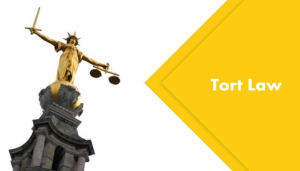XI REMOTENESS OF DAMAGE
– concern is with the realtionsip btwn the D’s neg’t act and the specific damages sought
1. Directness Versus Foresee ability
a) THE DIRECTNESS TEST
– if it can be found that the D’s act was neg’t. s/he will be held liable for all damages flowing as a direct consequence of that breach. (Re Polemis and Furness, Withy & CO. 1921 KB) –
– test has since been rejected as unfair, illogical, unworkable, too propolaintiff anf theoretically unsound – fails to relate teh degree of defendants fault to the extent of his liabilty
b) THE FORSEEABILTY TEST
Wagon Mound No. 1 (1961 PC)- oil flowing into Sydney Harbour causes a massive fire, owners knew oil has spilled but didn’t do anythingabout it – rejection of Polemis test, liability for a consequence will be imposed where that consequence is reasonably forseeable, natural, or necessary or probable
2. Modifications to the Forseeability Test
a) THE KIND OF INJURY
Rule: it is only necessary that a kind/type of injury is forseeable, do not have to forsee the full extent of the njury or the manner in which it occured to recover damages
Hughes v Lord Advocate (163 HL)- liablitly found for workmen who left an openmanhole surrouned by burning oil lamps unattended – one lamp fell in, exploded casuing boy passing by to fall in and be burned – held that even though nature of accident was unforseeable, forseeable that someone could be burned by unattended lamps
b) THE THIN SKULLED PLAINTIFF RULE
Rule: take you victim as you find him, to incur liabilty need only forsee intial harm done, not consequences that flow as aresult of Ps “thin skull”
Smith v Leech Brain & Co. (1962 QB)- D found libale for full extent of damages claimed by P wich flowed from his cancer, the development of which was promoted as a consequence of a burn (which was reasonably foseeable)to the lip where there was an already existing premalignant growth “the test is not whether these employers could reasonably have forseen that a burn would casue cancer and that he would die.
The ques’m is whether these employers could reasonbly forsee the type of injury he suffered, anmely, the burn. What, in the particular case, is the amount of damages whihc he suffers as a result fo the burn, depends upon the characteristics and conditions of the vicitm”
Marconato v Franklin (1974 BC SC)- damages awarded to a woman who underwent a sever ppersonality change as a result of minor injuries sustained in a motor vehicle accident. Although this was highly unusual and not forseebale, it was a result of her physical makeup.
*note: do not confuse this with the negligent infliction of nervouse shock – liabilty for that is assesed under special duty of care principles!
THE POSSIBILTY OF INJURY
Rule: if it is clear that a reasonable man would have reaslixed or forseen and prevented the risk defendant will be liable for damages
Wagon Mound No. 2 – D held liable for damage to small boats even though risk was small a prudent engineer would have forseen it.
Rule: Liabilty will flow if one can forsee the consequences of an action in a general way. The extent of the damage and its manner of incidence need not be forseeable if physical damage of the kind which in fact ensues is forseeable
Assinaboine V Winnipeg Gas (1971 Man CA) – toboggan struck a gas riser causeing an explosion- foiund laibilty where damages arising from impact of tobboggan were forseen even though the damages of the fire were not.


Be First to Comment